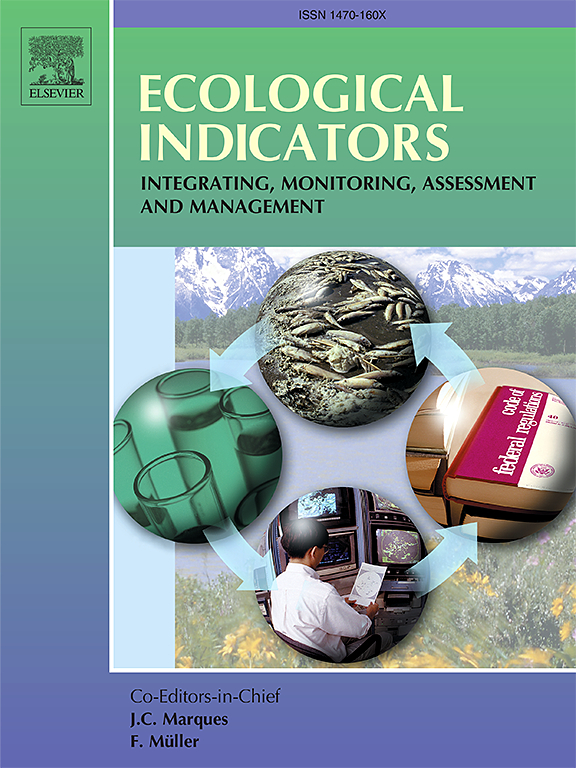使用基于ALS数据的半自动方法确定波兰森林的垂直结构
IF 7
2区 环境科学与生态学
Q1 ENVIRONMENTAL SCIENCES
引用次数: 0
摘要
森林的垂直结构是森林经营的关键特征之一,影响着生物多样性、资源竞争和各种生态过程。尽管它很重要,但确定大面积林分的垂直结构仍然是一个挑战。本研究首次使用机载激光扫描(ALS)数据对波兰的垂直森林结构进行了全国范围的评估。本研究提出了一种半自动的方法,可以在不需要大量野外调查的情况下将林分分为垂直结构类。该方法的主要优势和创新之处在于,可以在几乎没有现场采集数据的情况下建立和验证模型。通过处理从ALS数据中提取的点云指标,并采用机器学习技术,特别是随机森林算法,该方法生成了全国范围内的高分辨率垂直结构图。所建立的五类模型的总体精度为0.78。结果表明,波兰森林主要以单层垂直结构为特征,受苏格兰松优势的影响,在山区和生物多样性丰富的地区结构更为复杂。该方法大大减少了与传统森林调查相关的成本和时间,为森林监测、生物多样性评估和可持续管理提供了可扩展的工具,特别是在环境条件不断变化和栖息地丧失的情况下。本文章由计算机程序翻译,如有差异,请以英文原文为准。
Determining vertical structure of forests in Poland using a semi-automated approach based on ALS data
The vertical structure of the forest is one of the key characteristics of forest management, influencing biodiversity, resource competition, and various ecological processes. Despite its importance, determining the vertical structure of stands over large areas is still a challenge. This study presents the first country-wide assessment of the vertical forest structure in Poland using airborne laser scanning (ALS) data. The research introduces a semi-automatic method for classifying forest stands into vertical structure classes without the need for extensive fieldwork. The main strength and innovation of our approach is demonstrating that a model can be built and validated almost without field-acquired data. By processing point-cloud metrics derived from ALS data and employing machine learning techniques, particularly the random forest algorithm, the method generated a high-resolution vertical structure map across the country. The five-class model developed had a overall accuracy of 0.78. The results show that Polish forests are predominantly characterized by a single-story vertical structure, influenced by the dominance of Scots pine, with more complex structures in mountainous and biodiversity-rich areas. The methodology significantly reduces costs and time associated with traditional forest surveys, offering a scalable tool for forest monitoring, biodiversity assessment, and sustainable management, particularly under changing environmental conditions and habitat loss.
求助全文
通过发布文献求助,成功后即可免费获取论文全文。
去求助
来源期刊

Ecological Indicators
环境科学-环境科学
CiteScore
11.80
自引率
8.70%
发文量
1163
审稿时长
78 days
期刊介绍:
The ultimate aim of Ecological Indicators is to integrate the monitoring and assessment of ecological and environmental indicators with management practices. The journal provides a forum for the discussion of the applied scientific development and review of traditional indicator approaches as well as for theoretical, modelling and quantitative applications such as index development. Research into the following areas will be published.
• All aspects of ecological and environmental indicators and indices.
• New indicators, and new approaches and methods for indicator development, testing and use.
• Development and modelling of indices, e.g. application of indicator suites across multiple scales and resources.
• Analysis and research of resource, system- and scale-specific indicators.
• Methods for integration of social and other valuation metrics for the production of scientifically rigorous and politically-relevant assessments using indicator-based monitoring and assessment programs.
• How research indicators can be transformed into direct application for management purposes.
• Broader assessment objectives and methods, e.g. biodiversity, biological integrity, and sustainability, through the use of indicators.
• Resource-specific indicators such as landscape, agroecosystems, forests, wetlands, etc.
 求助内容:
求助内容: 应助结果提醒方式:
应助结果提醒方式:


